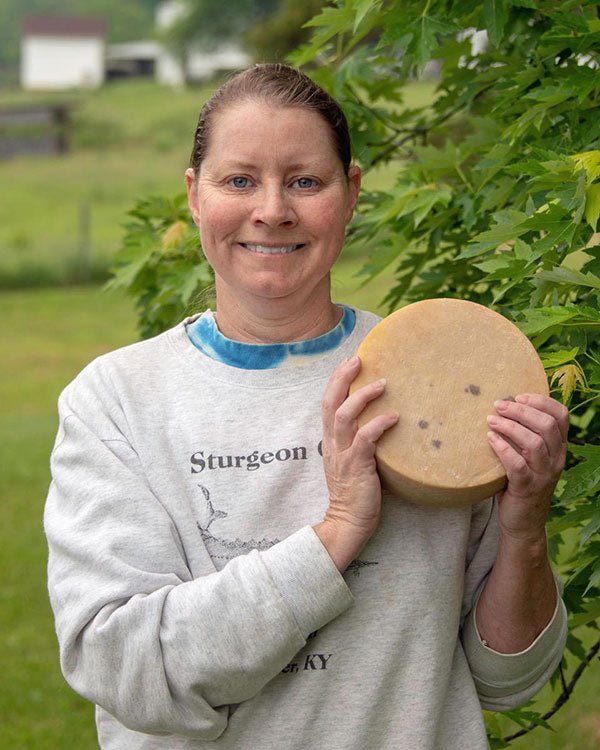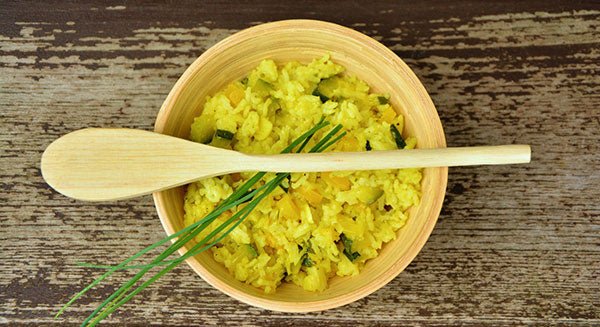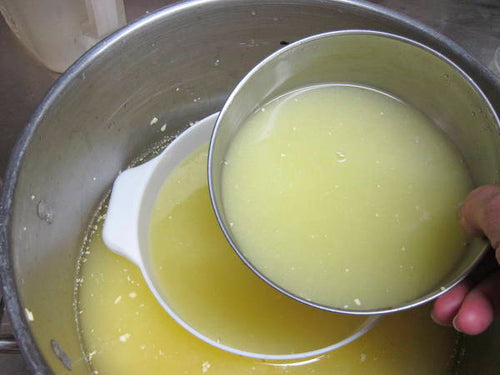
Kathy with her Sbrinz cheese.
Kathy Rowe and her husband Scott are both retired from the air force. They have 100 acres (Sturgeon Creek Farm in eastern Kentucky) where they raise goats, chickens, horses, a pig and lots of dogs. They sell hay, eggs and poultry.



Sherman- the barn “security” guard.

Galveston, imported warmblood stallion.

The goats snuggled down on a cold Kentucky day.

The “sheepies:” DG, Lazy Susan, and Rambeau (he’s on loan).
In addition to their own house, there’s a cozy, 100 year old farmhouse on their property which they rent through airbnb.

 Kathy’s Story
Kathy’s Story
I got into cheesemaking by accident. My husband and I had been part of a cow share and really liked the raw milk. We have a farm and plenty of room for animals, so he suggested we get a couple of milk goats.

After some asking around, I found a local lady who had two in milk she was willing to part with. We bought them and a doeling as well. After milking them a couple of days, we quickly realized we can’t drink over a gallon a day!

I’ve always loved cheese – as a kid I’d cut off huge hunks of orange store-bought cheddar and eat it with nothing else on a hot summer day. I may have loved it, but had NO clue how it was made. After some searching on the internet, I came across New England Cheesemaking Supply and ordered the Basic Cheesemaking Kit.
After playing around with some of the recipes (I learned I just cannot make mozz!) and started experimenting with the “harder” cheeses – I was hooked. And since October of 2015, I’ve made over 480 wheels of cheese in varying kinds and styles. My favorite is probably farmhouse cheddar because it’s so versatile in adding things to it.

A mesquite smoked Goatchego (goat version of Manchego).

A farmhouse cheddar with passion fruit green tea/matcha salt, dusted with match tea.

Chernobly Cheddar- farmhouse cheddar recipe partly cheddared and the curds soaked in local Mirror Twin Brewing Chernobly Russian Imperial Stout.

Farmhouse cheddar with edible roses and rose flavoring infusion.

Pepper Jack in a custom mold.

Colby
With our own dairy goats (and I have friends with cows), milk is not a problem. I purchased a couple of Katahdin sheep to mow the lawns around the barnyard and hope next spring to have some lambs and then sheep milk to work with.
My equipment:
My cheese cave is a double wide commercial refrigerator that’s been modified to hold proper cheese happy temps. The really cool thing about this fridge is I have not had to add any sort of additional humidity – it seems to run nicely at 85-90% RH all the time.
There are times it’s nearly full with wheels of traditional cheddar, Farmhouse Cheddar, Colby, Monterey Jack, Goatchego, Gouda, Ricotta Salata, Havarti, Edam, Barefoot Friar, White Stilton, and a host of other interesting ones.

The “Grotto”

My presses. I’ve found vintage fruit/lard presses work great for cheese. There is a learning curve on how much pressure to apply, but once you get it, the cheese turns out amazing. Best place to find them is ebay.

Assorted molds, presses, and other goodies I use for cheesemaking.

Cream separator. Since goat milk is naturally homogenized, I have a separator, but as of late, it’s hardly been used, due to making so much full-fat cheese.
Life Before Cheese:
I spent 20 years in the U.S. Air Force before retiring and becoming a farmer. My job in the military was radiologic technologist- aka, x-ray technician. I made it to the rank of MSgt (E-7) and specialized in Computed Tomography (CAT scan) as well as performed mammography, fluoroscopy, and routine x-rays.

There were many times I had to assist in special procedures requiring aseptic technique, which I think helps me a lot when it comes to cheesemaking. When dealing with raw milk, clean is paramount, and 20 years of having to keep things clean helped.
I’m also an author of 16 books, but right now I’m so busy I don’t have much time to sit down and get cozy with my characters. (https://www.amazon.com/K.-Rowe/e/B003H2UCNI/ref=ntt_dp_epwbk_0)

At the Lexington Comic and Toy Convention where I share booth space with an artist friend of mine.
Other Interests:
On top of making cheese 3-5 days a week, I also breed heritage poultry. My main focus is Jersey Giant chickens, but I also breed Royal Palm and Black Spanish turkeys, and a variety of duck breeds.

Thomas & Puff, Royal Palm toms

Our mixed flock of ducks.

Cayuga egg

Weirdo lives in the guest bathroom since there was no room at the barn for him. He’s the unofficial Clay Co. Farmers Market mascot, and even has a book about him: It’s Okay to be a Weirdo.

Hopes & Dreams:
I’m working with some of our local legislators to get a bill passed that would make raw and small dairy legal in KY. We were making headway when the virus shut down the legislative session. So, we’ll have to try again next year.
When I mention I make raw milk cheese, most folks look at me like I came from the planet Mars. No, I’m not some alien who settled here and decided raw milk is the best thing on earth. For thousands of years man’s been drinking raw milk.

We’ve only been pasteurizing milk since the 1800s. So why has mankind not been exterminated beforehand? Evidently raw milk isn’t so bad. You can buy raw milk cheese at Kroger, Trader Joe’s, and even on Amazon/Wholefoods.
How can raw milk be safer than store bought? When I milk my goats, I know the health of them. I know when someone doesn’t feel well, or looks a bit off. Action can be taken to get that girl healthy again quickly. When I milk, I use an iodine based udder wash suggested by my friend, who’s a PhD in microbiology with a background in dairy. After milking, the milk is strained and quickly cooled. Everything is washed and sanitized.

When it’s kidding season, as soon as the kids get weaned, I take a sample of each girl’s milk to the University of Kentucky and have it tested. If everyone is good, I can resume making cheese. In today’s world, we have technology and science on our side. There’s no reason raw milk can’t be as safe or safer than milk in the store. It may have a shorter shelf life, but it has all the flavor that pasteurized milk has cooked out of it.

And it’s for this reason that I’ve become a champion of small dairy and raw milk cheesemaking in Kentucky. With the collapse of the milk market, farmers have been looking for ways to keep their herds and still be able to make some money to keep the farm running. Cheese is a viable option that can be started on a small scale, and if profitable, be scaled up to meet demand.
I’ve been actively working with one of our state representatives to get a bill passed (HB 39) which would allow farmstead/artisan cheesemaking (and other dairy products) to be made at home. It’s modeled after New Hampshire HB 1402. The bill caps the amount of milk at 20 gallons a day, which for larger homestead dairies, might not be enough, but for smaller operations, it’d be perfectly fine. It allows for raw or pasteurized milk to be used, and products could be sold on-farm, at farmers markets, and other venues. There’s also the possibility of commercial use in small restaurants.
With the health food craze going on, folks are looking for REAL food. And many of them want to support local farmers. Being able to sell my cheese at the local farmers market could be a real game changer for our small farm. We were making headway this legislative session, and then the coronavirus caused everything to be shut down, so we’ll have to try again next year. It’d be a dream come true to be able to offer my cheese to those looking for food that comes from as close to natural as possible. Fingers crossed…
Life During the Pandemic:
People ask me if I’m bored during all this social distancing. All I can do is laugh and tell them farmers have been social distancing for thousands of years. There aren’t enough hours in the day to get everything done. I keep telling myself that one day I’ll take a break, and then something “important” comes up and my free day goes out the window. Oh, to have a whole day to do nothing…
Advice for beginners:
Before you take the plunge and invest money into a hobby, do as much research as you can. Get a book, watch videos online, join Facebook pages, ask lots of questions. When you decide you’re ready, be prepared for problems and failures. Don’t let this discourage you. Take each step of the recipe and read it carefully, and then read it again.

The hardest part I had with cheesemaking was the lingo. I may have known the words, but HOW they related to the process seemed to elude me. Videos helped a lot with connecting my mind to the terminology. Some folks will tell you that you’re supposed to make just ONE kind of cheese your first year. This is so you can master the technique for that kind of cheese. Well, if I did that, I’d have quit making cheese four years ago!
I went through my Home Cheese Making book and looked at every recipe.

(Note: There is a new edition of this book – click here)
Then, I decided what I had available in terms of cultures, equipment, and time. The first cheese I tried was mozzarella, and it was an epic failure! So I decided to try a farmhouse cheddar recipe. And that was it. Destiny spoke, and I was to make hard cheese.

I quickly went from farmhouse cheddar to Monterey Jack, Colby, Gouda, and then on to traditional milled cheddar. Now, I have enough cultures and equipment to make dozens of different kinds of cheeses.

The only kind I draw the line at is blues is because the invasiveness of the P. Roqueforti mold. It’s bad enough I have to fight the native molds already endemic to the farm.
And one very important thing: eat lots of cheese – not just your own, but find the best cheese counter in the area and try/buy small pieces of cheese to taste what the professionals are making. This is highly inspirational!

Lastly, have fun. If it’s not fun, it’s not worth doing.
Sturgeon Creek Farm
3815 Big Barn Rd.
Tyner, Kentucky 40486














































































































































